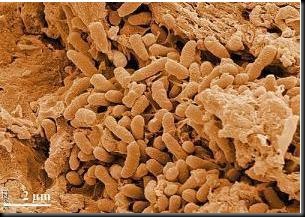Disease-causing bacteria can help in the fight against cancer. This may sound a little far-fetched at first, but in future bacteria could form the basis for innovative tumor therapies. Researchers at the Helmholtz Centre for Infection Research in Braunschweig have succeeded in planting "remote-controlled" salmonella in the tumors of cancer-bearing mice. The genetically modified microbes can produce substances on command. "Perhaps at some point," hopes Helmholtz scientist Dr. Holger Loessner, "we will be able to make these bacteria secrete cell toxins precisely where they are needed: in the middle of cancerous tissue."
Dr. Loessner's hopes are based on a curious phenomenon that researchers have known about since the mid-19th century. When tumor patients encounter a bacterial infection, frequently tumors are colonized by the bacteria and provide a niche for their multiplication. What exactly triggers this behavior is not well understood. "We suspect that the dead tissue inside the tumor provides these bacteria with a protective and nutrient-rich environment, and therefore, attracts them," explains Dr. Siegfried Weiss, head of the project group "Molecular Immunity" at the Helmholtz Centre for Infection Research. "Tumor interiors," he adds, "are low in oxygen, conditions under which many types of bacteria thrive."
For Weiss, Loessner and their colleagues, more important than the basic principles are the possibilities this phenomenon opens up. The rush by bacteria to colonize tumors suggests this behavior could be used for human benefit. Weiss and Loessner have now shown that this is essentially feasible. For the first time, they inserted in bacteria of the genus Salmonella typhimurium, a gene cluster which can be "switched on" by administration of a simple sugar molecule called L-arabinose.
Applying L-arabinose, after the salmonella bacteria have infected mice and migrated to the cancerous tissue, activates these genes. Thus far, Weiss and Loessner used genes that encode light emitting proteins. If the mice are given a dose of the sugar, bacteria that have colonized the tumor fluoresce, such that the location and size of the tumor can be analyzed. Theoretically, instead of emitting light, the bacteria in future could be triggered to produce and deliver cancer-fighting medication inside the tumor.
Alternatively, they could also deliver immune-stimulating substances that would mark the tumor for the body's own immune-defense mechanisms and induce a salutary immune response. "For medical purposes, of course," notes Dr. Loessner, "we would not use dangerous pathogens, but rather mutant strains that are harmless to humans."
"Until now, people have viewed salmonella as a threat to their health," says project leader Weiss, "so there would be a certain charm in using such bacteria for treatment of such a terrible disease as cancer."
Source: Sciencedaily


No comments:
Post a Comment